We’ll remember August 10, 2020, forever. On that day the wind changed Eastern Iowa and Winding Pathways in a way that will persist for a century. In 40 minutes, straight-line wind gusts up to 140 miles an hour toppled or broke 47 of our 53 trees. Two landed on our roof.
Our property adjoins Faulkes Heritage Woods, a 110-acre preserve of tall old trees, mostly oaks. The derecho felled most of its big trees that tumbled into a jumbled mass of trunks, branches, and leaves.
- The pine toppled onto the cabin roof.
- Effects of straight-line winds.
- Twisted trees.
Wondering how the great change would impact wildlife, we quickly noticed two short term impacts. August and September are usually slow months for bird feeder visitors as birds normally have plenty of wild food. As soon as the wind calmed, all was still. Faithfully, Rich found and filled the feeders. The next morning, we noticed heavy use by house finches, titmice, nuthatches, cardinals, woodpeckers, and chickadees. It was almost like the feeding frenzy that happens as a winter blizzard approaches.
Short Term Impacts
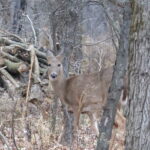
Trails are disrupted.
We quickly realized that deer, raccoons, coyotes, woodchucks, squirrels, and even chipmunks experienced a life-changing event. Their travel corridors changed as huge trees blocked deer trails, for example. They had to find new routes through the debris. One afternoon we saw a mother deer and fawn walking on the one remaining “open” trail around our prairie. Then, they crawled under a fallen tree and disappeared into the maze of branches. The ever clever raccoons have become more than pests as they tear up feeders and raid garbage cans. Also, the storm destroyed this year’s acorn and walnut crop, nuts that many species require. That is why the birds came so readily to the feeders. And still do!
- The house finches eat serenely.
- Even the crows come around to grab a snack.
- From early light to last dusk chickadees work the feeders.
Longer-Term Impacts
We are now watching for the long term impacts of the loss of so many trees. Our good friend, Jim Berry, is the former executive director of the Roger Tory Peterson Institute in New York. We asked him what we might expect following the loss of so many big trees in Faulkes Woods and our property.
“There are winners and losers. I would expect to see fewer wood thrushes, ovenbirds, and scarlet tanagers. They prefer mature forests. The more open woods and sunshine hitting the ground will cause an increase in cardinals, robins, and white-eyed vireos,” he said.
We have been fortunate to enjoy seven woodpecker species over the years. Some will benefit and some will lose from the great woods opening windstorm. According to Jim red-headed, red-bellied, and downy woodpeckers are likely to increase. So will flickers.
But sapsuckers and hairy and pileated woodpeckers that like the old trees and a closed canopy will probably decline.
- The small mammals are hungry.
- Owls will benefit from broken trees as cavities develop.
- Raccoons ravage feeders at night.
The loss of hollow trees that shelter animals and the destroyed nut crop are going to make this a lean winter for squirrels. Deer, blue jays, woodchucks, chipmunks, and wild turkeys will also miss the acorns that normally rain down each fall.
We were saddened to lose so many trees but look forward to watching the forest restore itself. We’re also watching to see changes in wildlife.

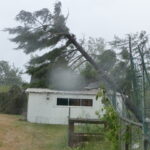
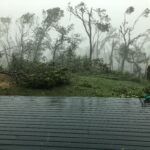
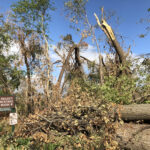
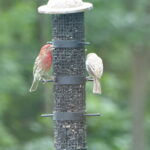
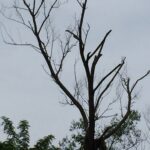
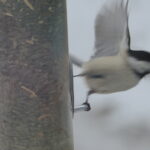
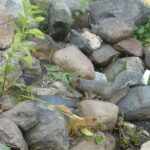
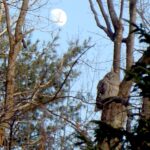
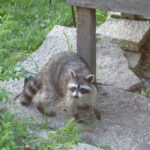

Thank you, Manny and Rich, for your updates on the effects of the derecho in August that ravaged eastern Iowa. Even though the derecho here nine years ago wasn’t fun and there was wood loss, I think we made out really well compared to Iowa. Wildlife is, I think, more resilient that humankind in most cases. I can see the doe and fawn you mentioned in my mind’s eye as they worked their way through the tangled mass. Peace to all.
Hello Winding Pathways,
My name is Morgan Christensen I am 13 years on and in 7th grade attending Madrid jr. sr. high IA. I want to speak with you about my project “2020 Derachos Effect on Iowa Native Birds” and how we can take action to help them. With my project, I learned a lot! One thing is why Iowa native bird populations are so important in the first place. I learned how they are adhesive seed dispersals and how they have a large impact on insect populations since they eat 20 quadrillion individual insects a year. This is extremely important to Iowa since insects can destroy are crops. I also learned why it’s important for Native birds not to overpopulation because they will overuse resources and make it harder for other animals to survive.
With this, I jumped right into my project and first chose Boone County, Madison County, Linn county, and Dickonson county For the following reasons.
Boone and Linn’s county were directly in the Derechos pathway receiving 140mph winds.
Dickinson county was out of the Derechos pathway.
Madison only received a high of 60mph winds.
This gave me many different viewpoints on how Iowa native birds were affected by the derecho.
Next, I had to choose 3 different Iowa native birds. I chose the Northern Cardinal, American Goldfinch, and Black-Capped Chickadee since they stay in Iowa year-round and they are all very native to Iowa.
After I chose my four counties and top three native birds I used the Audubon Christmas bird count to chart and graph my data.
(if you would like to see my graphs and charts please respond to this email)
After looking at my data I had many questions so I went and spoke to the Dallas county naturalist (Mike Havlik). I asked him
1.) how was each bird affected?
2.) why were the Iowa native bird population numbers so low in 2019? Did this have to do with COVID-19?
3.) How can we help Iowa native birds?
AFTER INTERVIEWING WITH MIKE HAVLIK:
How each bird was affected:
AMERICAN GOLDFINCH: Goldfinches are very migratory meaning they move around a lot through and around Iowa. The derecho in 2020 made the goldfinches migrate and then returned in 2021. This is why the American goldfinches numbers dropped in 2020 and then raised rapidly in 2021.
BLACK-CAPPED CHICKADEE: The derecho helped the black-capped chickadee since they are cavity nesters meaning they used the dead trees and broken limbs for shelter and nesting. As a result, this raised the chickadee’s population numbers in 2020 but in 2021 after everyone cleaned up the dead trees and limbs, making the black-capped chickadee lose a lot of shelter and nesting area. Making their population numbers drop.
NORTHERN CARDINAL: Northern Cardinals are very resilient this means able to withstand or recover quickly from difficult conditions. This is most likely what happened to the Northern cardinal making their population numbers stay steady and continuously raise over years.
why the Iowa native bird population numbers so low in 2019:
There were a lot more bird counters in 2020 and 2021 rather than in 2019 when there were a lot fewer bird counters. This is caused by covid in such a way as…
2019-people were busy and didn’t have the time to count birds.
2020-covid hit people were always stuck at home and had time to watch birds.
2021-covid is still here and there were fewer counters but still more than 2019.
How to help Iowa native birds:
The main way we can help Iowa native bird populations from future storms, similar to the derecho, is by planting native trees such as oak, black cherry, walnut, and hickory. Iowa native trees produce a mass amount of including shelter, food, and nesting. One aspect is Iowa native trees make great homes for caterpillars. Caterpillars are extremely important to Iowa native birds. For example, it takes 6000-9000 caterpillars to feed four baby Black-Capped Chickadees.
In conclusion in my project, I found that all the birds were affected by the derecho but not all in negative ways. I plan to continue with my research and watch the Audubon Christmas bird count numbers in years to come.
This project has won:
Western Iowa Science and Engineering Fair-
US NAVAL award
wildlife and ecosystem WISEF award
1st in middle school biological sciences
Broadcom masters (national award)
State Science and Technology Fair of Iowa-
Certificate of excellent
Best use of the international system units
2nd place in Larry Schwinger SSTFI seminar (physical sciences)
2nd place for environmental sciences
Broadcom Masters award (again)
Champion overall
I hope you enjoyed reading through my project. This project means a lot to me since it’s not only letting me interact with ornithology but also helping Iowa native birds. I noticed your website has a lot of take-action plans. This wanted me to share with you mine. I plan to buy a large number of native trees to donate to the community. If I share with them my project and goal this could encourage the community to get more involved with birds and help the Iowa native birds themself. I was wondering if you would like to help me with this plan to help native birds.
Sincerely,
Morgan Christensen
Thank you, Morgan, for this detailed report! Birds are fascinating, learn, and are harbingers of either good or danger or bad ways people use the environment. Be well. M~